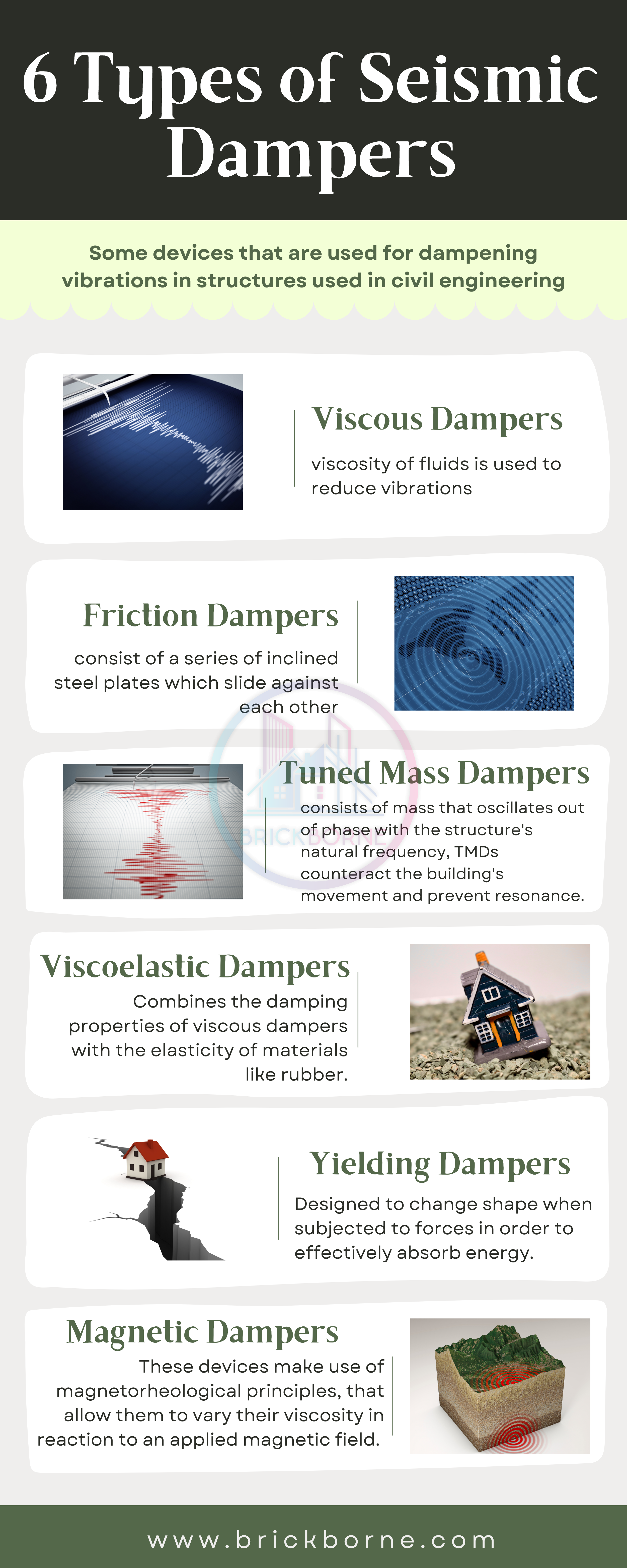Engineers have devised some devices that are used for dampening vibrations in structures used in civil engineering. These devices act as shock absorbers for building. We are talking about seismic dampers. These devices dampers earthquake vibrations. Apart from earthquakes, they are also helpful to reduce vibrations induced by wind forces in high-rise structures. In this blog we will explore the different types of seismic dampers.

1. Viscous Dampers
Viscous dampers are commonly used in civil engineering structures. They reduce the vibrations induced by both earthquake and winds forces which are dominant in high-rise structures. In Viscous dampers viscosity of fluids is used to reduce vibrations. There is a fluid-filled chamber (Low viscosity fluid) and piston. Piston moves which creates resistance allowing for the conversion of kinetic energy into thermal energy. These are the most used dampers in buildings.
Advantages of viscous dampers
- Viscous dampers have good durability.
- They are suitable for a wide range of earthquake frequencies.
- Can be used for broad range of earthquake magnitudes.
Disadvantages of viscous dampers
- Skilled personals are required to carry out construction and installation processes.
- In case of fluid leakage, performance of dampers can reduce over time which must require maintenance on time.
- They have a high initial cost.
2. Friction Dampers
These dampers are also type of seismic dampers. As the name suggests these dampers dissipates energy by means of friction. These dampers consist of a series of inclined steel plates which slide against each other. Because of the special surface treatment performed on these steel plates, they can produce a lot of friction. Friction pad material is also placed in between plates.
Advantages of friction dampers
- Since bolting together steel sections and steel plates is required, installing the friction damper is simple to perform.
- As they can be easily hidden between walls, they do not affect the aesthetic of the building.
- Friction dampers are economical.
Disadvantages of friction dampers
- Unlike viscous dampers, they are not designed against deflections due to wind forces.
3. Tuned Mass Dampers
Tuned mass dampers, also named as a harmonic absorber or seismic damper, are attached to building/structure to decrease earthquake induced vibrations. TMDs consists of mass that oscillates out of phase with the structure’s natural frequency, TMDs counteract the building’s movement and prevent resonance. They are particularly beneficial in tall buildings and structures with a single dominant frequency, reducing lateral and torsional vibrations resulting from seismic events.
Advantages of tuned mass damper
- TMDs effectively prevent resonance by counteracting the structure’s oscillations.
- Offer efficient vibration control, particularly in structures where we can predict certain range of earthquake frequencies.
Disadvantages of Tuned mass damper
- For structures with specific dominant frequencies, TMDs work best. Most structures might not fall into this category.
- TMDs are most effective for structures with distinct dominant frequencies. This might not apply for most structures.
4. Viscoelastic Dampers
It is one of the types of dampers for vibration. Viscoelastic dampers combine the damping properties of viscous dampers with the elasticity of materials like rubber. They are designed to resist vibrations due to low displacements. Thus, they are more effective against wind forces.
Advantages of viscoelastic dampers
- Effective for both wind and seismic loads.
Disadvantages of viscoelastic dampers
- Viscoelastic materials can degrade over time, potentially affecting their long-term efficiency.
5. Yielding Dampers
Yielding dampers are designed to change shape when subjected to forces in order to effectively absorb energy. Through this controlled deformation these dampers reduce the stiffness of the structure and allow for dissipation of energy.
Advantages of yielding dampers
- Yielding dampers efficiently dissipate energy by undergoing plastic deformation thereby minimizing the impact caused by forces.
- These dampers have the capacity to handle amounts of energy. They Can withstand strong seismic events.
Disadvantages of yielding dampers
- Following a seismic event, yielding dampers may require repair or replacement.
- Once yielding dampers have deformed, they may no longer be reusable. They Will need to be replaced.
6. Magnetic Dampers
These modern devices make use of magnetorheological principles, which are a special characteristic of some fluids that allows them to vary their viscosity in reaction to an applied magnetic field. Magnetic dampers are a revolutionary invention for earthquake protection.
Advantages of magnetic dampers
- Magnetic seismic dampers allow real-time adjustment of damping, enhancing adaptability to varying seismic conditions.
- These dampers provide precise control over damping forces, catering to specific structural requirements.
Disadvantages of magnetic dampers
- Complex installation process.
- Regular maintenance is required.
Seismic dampers represent a change, in the field of engineering allowing buildings to withstand the powerful earthquake and wind forces. Different types of earthquake dampers have their advantages and disadvantages briefly discussed above. As engineers and architects continue to improve and innovate shock absorbing technologies, our built environment becomes more resilient ensuring the safety and durability of structures in areas to earthquakes. The wide range of dampers available provides us with a set of tools to strengthen buildings/structures, against the constant threat of seismic events.







2 comments
Special Reinforced Masonry Shear Walls: All You Need to Know
[…] they ensure the stability and safety of structures by safeguarding against lateral forces caused by earthquakes and strong winds. A notable progress, in the realm of engineering and construction involves the adoption of […]
Important Effects of the Earthquake You Must Know
[…] As earthquakes are natural, we can not control the earth’s movements, however, we can take preventive measures to minimize the loss. In this blog, we will discuss the effects of the earthquake in detail. […]